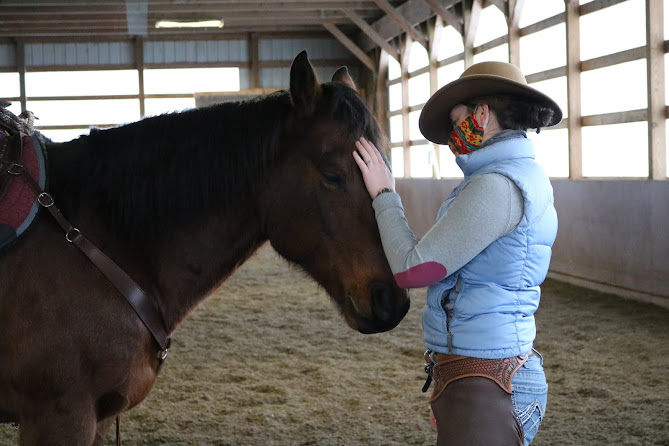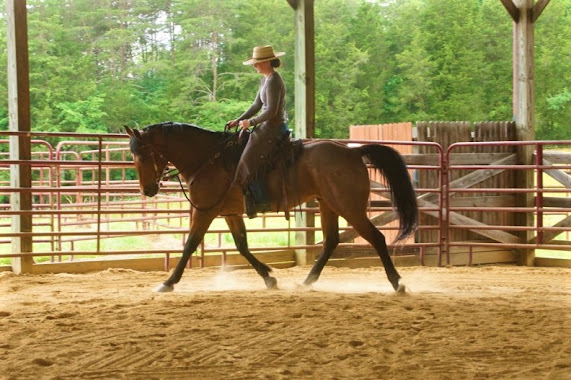How to Practice Riding When You're Not Riding
This has become a recent practice of mine. It's reasonable to assume that if you want to get good at a thing, you need to spend a lot of hours doing that thing.
This is true...to a point. Masters of any particular skill spend thousands upon thousands of hours practicing, certainly, but when it comes to something as multifaceted as riding, there are lots of individual skills that go into becoming really good. Many of these skills don't even require a horse to be within our view to practice and get quite good at. Here's just a few I've been playing with:
1) Practicing preparation for motion.
A good chunk of riding is being able to navigate the fine line of influencing the horse's movement and balance without causing him to get worried or defensive about it and it helps quite a bit if you have some control over your own balance prior to asking your horse to trust you with his.
Start to notice simple movements you make every day - sitting to standing (or vice versa) is a good one. When the thought enters your brain that you are going to get up, pause: how are you positioned? Do you have to torque your body to be able to stand in a way that has some smoothness and grace to it? Are you holding tension in a specific part of your body? Where are you looking when you shift your weight to rise?
Don't do anything different at first, just notice.
After you have a good idea of what you tend to do, start to rise with a bit more intention. Prepare more so you can do less.
Take a breath in before you shift your weight. Get your body positioned as square as you can.
Breathe out all the way down into the lowest parts of your belly, all the way down into your pelvic bowl, activating not just your rectus (the "six pack" muscles) but also your transverse and oblique abdominals.
Lift your chin and soften your eyes so you're not hard focused on any one thing but taking in your entire surroundings using your peripheral vision.
Feel your feet on the floor as you go to rise. Allow yourself to lift up from seated position by folding slightly at your hips and following your soft gaze upwards. Take a deep breath in through your nose and exhale through your mouth.
You have hundreds if not thousands of opportunities each day to practice preparing to move. Why is this important, you might ask. Imagine using a hand saw. If your motions are smooth, elongated, with even pressure and rhythm, you will make quick, clean work of whatever you're cutting. If your motions are sporadic, irregular and lacking in ease, you're going to make a hack job of your work and probably cut yourself in the process. It's not too much of a stretch of the imagination to consider how these two scenarios might feel to the horse if the tool is the reins and the bit.
2) Learn to breathe properly.
Most of us don't put our diaphragm through its full range of motion when we breathe. We breathe into the highest parts of our chest cavity - usually recruiting the accessory breathing muscles of your upper back and neck - to help us draw in air, and we don't exhale all the way down into our bellies and engage our large transverse and oblique abs, which create a girdle effect on our midsection. This results in a rigid diaphragm and corresponding tension in our hips and pelvic floors. The list of physical maladies associated with poor breathing mechanics is endless: I could write an entire blog series on why this is so important (maybe I will one of these days). In the meantime, Google is your friend.
Again, why is this important? I cannot imagine you haven't thought of at least a few reasons why, but if you're stumped it's okay, I'll offer you this: breathing is controlled by the autonomic nervous system. Autonomic in this sense = automatic, which is why we can breathe without thinking consciously about breathing. But while this function would occur even if our thoughts are occupied by something else, our bodies will adapt several other important functions like muscle tone, heart rate, cortisol/adrenaline levels and nerve reflexes based around our breathing (you may recall the terms "sympathetic and parasympathetic nervous systems", better known as "fight or flight" and "rest"). Bottom line: if your tendency is to breathe quick, high and shallow, you are likely perpetually operating in a state of semi-tension and stress. Your horse will feel that a mile away.
(Also, I'm pretty sure I heard somewhere that your core plays a huge part in riding. Just sayin')
3) Use road rage as an opportunity to practice being present.
Yes, I'm looking at you (while at the same time turning the finger on myself). We all do it. Maybe you don't go full Hulk, but I'd bet money that at some point in the last week you've been stuck behind an abysmally slow driver, missed a light because the guy in front of you was on his phone or got stuck in a line of traffic.
Our entire lives are made up moments where we largely have little to no control over what happens. Driving seems to be endlessly filled with these moments, so use them. After you learn to breathe (see #2), use this newly acquired skill to bring you back into your body. When you are stuck in traffic, sitting at an endless red light or growing old behind that guy doing 10 under, take a deep breath.
Where are your thoughts? What are you so worried about? Why does this moment where you don't have control cause you such stress? Do you really have somewhere to be right now? And even if you do, is raising your blood pressure going to suddenly give you the gift of teleportation?
Breathe. Stop straining your eyes. Loosen your grip on the steering wheel. Unclench your cheeks. Unclench your other cheeks. Since you're here, look around. See if you can notice five things you might not have otherwise seen. Take a moment to actually view your surroundings instead of whizzing singular-mindedly past them. Breathe some more. Make like a bobblehead: let your skull float on your cervical spine as if there were a fluffy cloud layer between them. Say something assuring to yourself: "I don't need to take on this particular worry right now" or "this feeling of anxiety isn't serving me in this moment" have become two of my go-to's.
4) Before you open your mouth, ask yourself: is what I'm about to say helpful? Is it necessary? Is it kind? If it isn't kind, is at least one of the other two things?
I'll admit, this is hard, but it's become kind of a personal mantra for me. I am certainly not the first person to make friends with the Drama Llama: it's an easy way to feel included when you otherwise feel out of place, something those of us with anxiety are very familiar with. Everything we do is a reflection of our own personal struggle: if you're riding the Drama Llama, check yourself to see how close your insecurity is to the surface (full disclosure: mine hangs out pretty close by, but the Drama Llama and I have agreed on a relatively laissez-faire type of relationship). You don't really care that Debbie Sue is completely overmounted on that 6yo Hanoverian. You DO care that no is saying you are. Drama isn't about the subjects, it's about the people who create it. It's normal to want to feel like part of the group - it's also normal to see or hear something and think to yourself, "Christ, that's a hot mess/dumpster fire/cluster foxtrot..."
You know who I share that stuff with? My husband. Ober is the type of guy who can sit there and look me straight in the eye while I let loose every petty injustice and salacious tidbit of the day, say things in between points like "Oh, absolutely" and "That's crazy!", smile when I'm done talking and say "Feel better?" and not be in the slightest bit condescending about any of it. He knows that if I'm actually talking about it, it must have hit at something tender within me and I need to exercise it in a safe way. He knows that all of my words really translate to one simple sentence: "I feel scared and insecure."
I hope you have someone who is able to do this for you. In the meantime - and even if you do - use this mantra, or find a similar one that works better for you.
Notice that none of these practices involve gym memberships, purchasing expensive new gadgets or any other great expenditure of resources. You just need to be willing to try.


Comments
Post a Comment